Rug Hooking – An American Fiber Folk Art– An introduction
Written by Laura W. Pierce
Photos courtesy of the Author
Rug Hooking is a thrifty craft and a fiber art that has come full circle. There are many styles of Rug Hooking, from using up scraps in simple geometric patterns to hand-dyed values of wool flannel in intricately designed patterns to combining with other fiber techniques. There is a social aspect to rug hooking since it is a relatively mobile fiber art and you can talk while you’re ‘hooking’ your pattern. Rug Camps and Hook-Ins are popular.
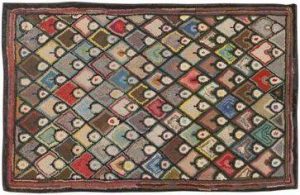
Geometric Scrap rug, Maker unknown
Some claim rug hooking is indigenous to the Maritime Provinces and New England States, while others claim that sailors on whale ships were already hooking with their walrus ivory hooks! As a simple craft of pulling strips of used clothing through a loose weave foundation, it could have started when people started making fabric.
Rug hooking has been well known to Antique Dealers. Rugs that were hooked on quality foundation with quality wool and taken care of, have lasted long enough to become antique and valuable. Here’s a beautiful rug with 5 cats and a colourful border from an old edition of Architectural Digest
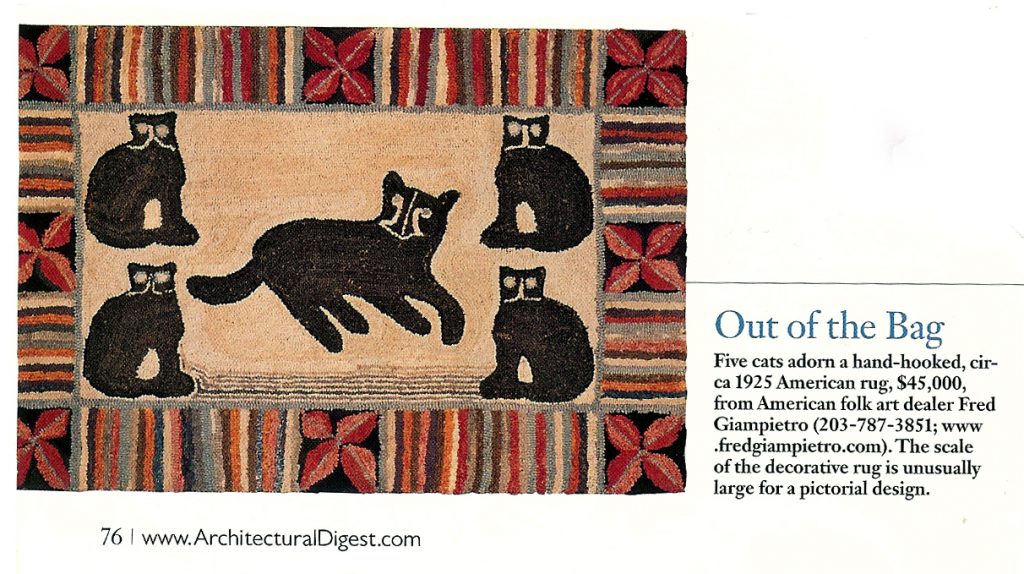
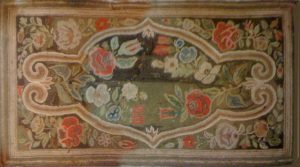
Here’s another old rug a friend of my mother’s gave me; I find it quite charming with its naive flowers and fleur de lise. But it was disintegrating before my eyes, so I photographed it before I threw it away and may hook something similar, someday. It probably had a dark background, but it had faded to reveal that various materials were over dyed dark and have since faded to brown and greens, creating an antique patina. Some contemporary rug hookers use faded colors in their rugs to go with their antique and folk art décor.
At the beginning, rug hooking was a humble craft that also offered creativity with design and colour. Rug hookers would design their own patterns, use traditional geometric designs or borrow designs from other decorative arts. Rug hookers could use whatever was at hand, from potato sacks with used or torn clothing, to new burlap or linen foundation with fine wool or yarn. The rugs on potato sacks didn’t last long, but could be replaced. A newly finished rug would go in the bedroom or living room; the replaced rug would move to a busier room, like the kitchen. Eventually, rugs would move to the back door, where they would be truly worn out, but still they were finally of use covering the woodpile.
Rug Hooking was popular in the 1800’s and early 1900’s and it flourished in the colder areas where winters were long. Folks made rugs and bed rugs as practical living and as home art.
Edward Sands Frost was a peddler whose wife was hooking rugs. He decided he could design rug
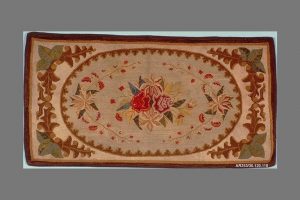
Hooked by Edward Frost, 1870 from the Metropolitan Museum
patterns with tin plate templates or cut-outs and introduced pre-printed patterns on burlap. His patterns were popular and by the time he sold his business to Ralph Warren Burnham, he had 180 pattern designs. Ralph Burnham was an antique dealer with an appreciation for fine hooked rugs. While he dealt in new and used hooked rugs, he also hired people to repair and duplicate hooked rugs..
Many entrepreneurs promoted rug hooking as a cottage industry. Dr.Grenfell, a missionary, set up an exchange store in Newfoundland to help the desperately poor. He solicited used clothing, designed patterns and offered money, food or supplies for hooked mats that met his standard of high quality workmanship. Tourists in Cheticamp, NS, and eastern Canada often bought these little mats and supported the cottage industry. Making mats became less of a creative endeavor and more of a chore. Read more about it atwww.grenfellhookedmats.com
Rug hooking in the 1940’s was taught to recovering war veterans as an easy, soothing and creative pastime for long recuperations and post trauma. Nearly everyone knew about hooked rugs and several books were published to instruct and inspire more rug hooking.
Pearl McGown was particularly successful in promoting a fine shaded type of rug hooking that helped her support her family. She sold patterns, taught her method to rug hooking teachers and started the National Guild of Pearl K. McGown Hookrafters. You can read about her and her legacy on the guild’s website: www.mcgownguil
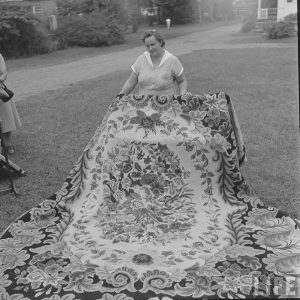
From Life archives: hook-in, possibly at Pearl McGown’s Rose Cottage
Through out the history of Rug hooking, there have been artists who have hooked a few rugs as another medium of their art. Marguerite Zorach was an artist in Maine and her daughter, Dahlov Ipcar, also an artist, hooked a few rugs. Both artists were featured in a well known and wonderful book; ‘American Hooked and Sewn Rugs’ by Joel and Kate Kopp, about historic rugs.
When some contemporary pattern makers ‘borrowed’ Dahlov’s design and renamed it ‘Tumbling Cats’, they gave her credit for the design, but didn’t contact her. As Dahlov was still living at the time, it eventually triggered some needed talk about copyright in design. Rug hooking and many fiber arts have a history of sharing and borrowing designs, so it is somewhat traditional. However, in these days of millions of graphic images, much more ‘borrowing’ is going on and borrowing designs without permission is stealing. Honoring copy right is being encouraged by the rug hooking community.
By 1979, an open rug hooking guild was proposed and started by Peg Hansen in Conn. It was to be: “a guild of rughookers who would freely share their talents and ideas without any person or group having any authority. Every member would have a vote in the organization.” It was named the Association of
Traditional Hooking Artists or ATHA: www.atharugs.com . At this time, there were many rug hookers who were hooking their own styles and designs, but finding that their rugs were not welcome in the McGown Guild. In an effort to keep rug hooking available and viable for everyone, ATHA members felt strongly that rug hooking would thrive in an open guild. ATHA keeps growing and establishing ‘Chapters’ all over the world. When a chapter started in Sonoma County in 1996, my mother was invited and I tagged along.
I am a 4th generation rug hooker and grew up with my mother’s hooked and braided rugs. She got her first rug hooking lesson from hermother and her first hook was her Aunt Em’s. Aunt Em’s rugs are long gone, as she used recycled materials as was the custom for farmwomen. I vaguely remember a rug hooked by my grandmother; it was of Ohio with all the counties outlined and a red heart whereGranville was. It was falling apart when my mother gave it a cousin.
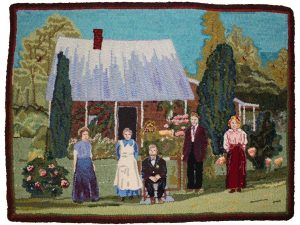
‘Lattas in Fox Hollow’, adapted from a b&w photo and hooked by Laura Pierce
My mother and I hooked our own designs and used recycled wool. She used store bought burlap and I used linen. After awhile, I started teaching rug hooking and attending rug workshops to expand my rug hooking expertise. My mother and I enjoyed rug hooking together for the last 19 years of her life. It is fun putting the colors together and if you don’t get it right, it’s easy to change your mind. Rug hooking is a forgivable fiber art that offers an outlet for creativity and community.
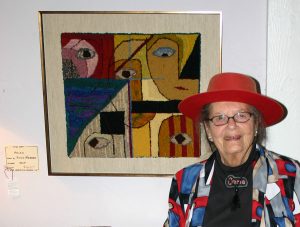
My mother, Emma Webber, with her ‘Helen and Friends’ rug at a 2003 rug show
In 2002, a photographer, Charlotte Bell, introduced rug hooking to a group of Mexican women as a way to help them make money. Many rug hooking chapters and groups donated materials and tools to these women, while individuals made pilgrimages to San Miguel de Allende, Mexico, to visit, deliver goods and buy hooked mats. They call themselves the Rancheritas and the sales of their rugs have helped their families and community.
In 2011, an artist, weaver and rug maker, Mary Anne Wise, introduced rug hooking and prosperity to women in Guatemala. The project includes a teaching and exchange program between the Guatemalan women and rug hookers from other countries which has boosted the women’s confidence and their earnings. There is a new book out about it called ‘Rug Money’, available on Amazon:
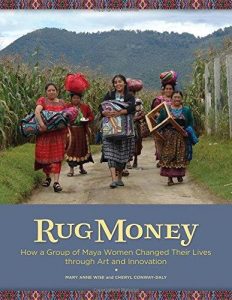
Rug money
These days, rug hooking includes many styles and room for everyone. Some rug hooking artists are experimenting with alternative materials and combining various fiber techniques. Others are painting in wool to create portraits, still life studies, landscapes and modern art, while others are happy making rugs for their floors and their friends’floors.
Information about Rug hooking is all over the internet and you can feast your eyes on beautiful and innovative rugs. In 2017, a video about the Oxford punch hook was illustrated on Instagram and ‘went viral’; Amy Oxford sold out of her hooks (and has ordered more) as people all over the world wanted to try this new-to-them fiber art! It is exciting time to be part of the rug hooking world and to see what is next!
I hope you will check it out.
Laura Pierce lives, works and teaches in Petaluma, California. Contact her at: www.flyingdoghookery.com